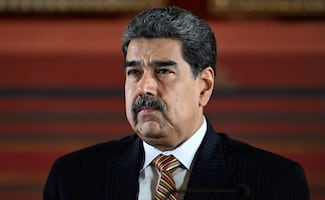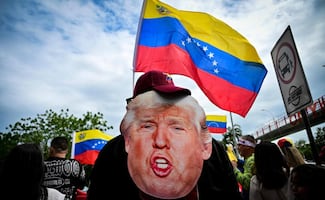Más Información

Nicolás Maduro dio pasaportes diplomáticos a narcos y facilitó aviones para lavar dinero hacia México; de esto lo acusa EU

Captura de Maduro es "un paso importante, pero no suficiente"; Edmundo González llama a una transición democrática real
Far away from the usual hotspots in the Middle East or Europe , India and China agreed to defuse tensions in the remote, yet strategic region of Ladakh in the Himalayas , where both countries fought a war in 1962.
Last week, government delegates from the two Asian giants announced their resolution to resolve a dispute over their border in Ladakh —an Indian union territory , part of the larger Kashmir region —through diplomatic channels.
During a videoconference, senior officials expressed that New Delhi and Beijing “should handle their differences through peaceful discussion,” and should not allow them to become disputes, the Indian Ministry of External Affairs ( MEA ) said. In Beijing , Geng Shuang , a spokesman of China’s Ministry of Foreign Affairs , told reporters that the overall situation in the border was currently “stable and controllable.”
Hours later, on Saturday, Lieutenant General Harinder Singh , commander of the Indian 14 Corps and a Chinese delegation headed by Major General Liu Lin , commander of the Southern Xinjiang military region , agreed to keep talking at the brigade and battalion commander level at the Moldo-Chushul border meeting point, some 4,260 metres above sea level.
According to Indian media, the standoff started on May 5 with a clash between the rival armies in the east of Ladakh . Nearly 5,000 soldiers from China’s People’s Liberation Army crossed the 3,488-km-long Line of Actual Control ( LAC ) established after the 1962 conflict to block road construction by India .
Chinese troops did have an advantage in the initial days at Pangong Lake and Galwan Valley , yet the Indian contingent was beefed up rapidly after additional forces underwent the seven days of acclimatization required to enable them to operate at 4,870 m height.
A number of soldiers on both sides sustained injuries, including 72 Indian troops in the confrontation at Pangong . The clashes involved fisticuffs and white weapons, as well as the deployment of helicopters, jet fighters, and heavy artillery.
Chinese analysts said for their part that India should immediately stop “ provocative acts ” along the boundary. The Indian military “must halt any construction of defense facilities across the border into Chinese territory in the Galwan Valley , and stop crossing the border to create conflicts”, stressed Song Zhongping , a military expert quoted by Global Times .
Hu Zhiyong
, a research fellow at the Institute of International Relations of the Shanghai Academy of Social Sciences , suggested that “the Indian side might have miscalculated the situation, and tried to press China to make a compromise by creating troubles amid the COVID-19 pandemic . India has clearly underestimated China’s capability to cope with the pandemic in the country.”
A bit of history
Located in the “ Roof of the World ” with a lowest elevation of 2,250 m in the Indus River , Ladakh (274,000 inhabitants) has been the subject of a quarrel since 1947 when India and Pakistan gained independence from the British Empire .
The name Ladakh means “ land of high passes ” in Tibetan / Ladakhi ; it connected India with the Silk Road and today plays an important role due to its road link between two Chinese provinces, Tibet and Xinjiang .
Tensions between New Delhi and Beijing increased after the former granted asylum to the Dalai Lama following the 1959 Tibetan uprising . India also rejected proposed Chinese diplomatic settlements regarding the border in Ladakh and along the old McMahon Line dividing Tibet and the northeast of India .
On October 20, 1962, China invaded the disputed territory; after one month and one day of fighting, Beijing retained its de facto control of the Aksai Chin —a desert uninhabited region the size of Switzerland claimed by New Delhi ,—declared a ceasefire and simultaneously announced its withdrawal to the LAC . More than 4,000 soldiers on both sides died, with many succumbing to the freezing cold temperatures.
This time, history finds China and India separated again more by ideological differences than border issues, despite its membership in the BRICS bloc and high-level bilateral meetings, such as the 2018 Wuhan summit between Chinese President Xi Jinping and Indian Prime Minister Narendra Modi .
While China’s economic rise is enabling the ancient Middle Kingdom to displace the United States as the world’s dominant power, Modi has opted for a realignment behind Washington’s Indo-Pacific strategy of “ containing China ” which fosters a new Cold War .
Recommended: The new Cold War: Thinking the unthinkable in the age of nationalism
As part of this, NATO Secretary General Jens Stoltenberg has declared that the Atlantic Alliance “does not see China as the new enemy,” yet it must be prepared to respond to Beijing’s growing military and economic strength . China’s increased cooperation with Russia , he underscored, entails a “security consequence for NATO’s allies .”
In addition, the Pentagon is planning to deploy ballistic missiles in Okinawa , Japan , after the Trump administration withdrew from the 33-year-old Intermediate-Range Nuclear Forces Treaty in 2019. Australia , the Philippines , and South Korea ruled out the possibility of hosting the U.S. missiles .
Recommeded: The nuclear clock keeps ticking: U.S. withdraws from Open Skies Treaty
Of course, this did not go unnoticed by China , who also took note of Modi’s warm response last week to the U.S. proposal of expanding the Group of Seven ( G-7 ) into a G-11 or G-12 that includes India . In a phone conversation, the nationalist Indian leader commended U.S. President Donald Trump for his “creative and far-sighted approach, acknowledging the fact that such an expanded forum would be in keeping with the emerging realities of the post COVID-19 world ,” according to the MEA.
“With its big power ambition, India has long desired to participate in world’s leading clubs. With a fresh border spat brewing between China and India in recent days, India also hopes to send a signal to China by endorsing the U.S.’s G-7 expansion idea ,” remarked an article published by Global Times .
New Delhi
, affirmed the article based on an interview with Liu Zongyi , expert of the China ( Kunming ) South Asia and Southeastern Asia Institute , decided in 2019 to upgrade its engagement with the Quadrilateral Strategic Dialogue (“ the Quad ”) composed by India , Australia , Japan , and the U.S. During Trump’s visit to India in February, both governments said they would enhance their relations to “ comprehensive global strategic partnership ” level.
The efforts to institutionalize the Quad , it added, and the intention to expand it to South Korea , Vietnam , and New Zealand “cannot be underestimated. It is fair to say India has been active in many U.S. plans that target China .”
Interestingly, the Chinese statement issued after the Ladakh crisis was deactivated last week, highlighted “the two countries should oppose politicising the epidemic situation,” and “support the World Health Organization .” This was not mentioned in the MEA’s press release.
Its Chinese counterpart also said both sides “will resolutely safeguard and promote multilateralism , oppose unilateralism , protectionism , and hegemonism , jointly safeguard international fairness and justice , and safeguard the common interests of developing countries .”
On August 5, 2019, India revoked the limited autonomy of Jammu and Kashmir , its only Muslim-majority state, stoking tensions with Pakistan and China . The state was also split and downgraded into two union territories ruled directly by the central government, Jammu and Kashmir , as well as Ladakh .
India
and Pakistan have fought three wars for the control of the Kashmir region , bordering China’s autonomous Tibet and Xinjiang provinces. The China Pakistan Economic Corridor , which Beijing considers as a means of circumventing American plans to blockade Chinese ports in a crisis, passes through Pakistan-held Kashmir .
For its part, India and China marked on April 1, the 70th anniversary of the establishment of bilateral diplomatic relations, a special moment which should inspire their leadership in the quest for peace and stability.
As one actor from past confrontations stated, VK Ahluwalia , director of the Centre for Land Warfare Studies in New Delhi , and former Corps Commander in Ladakh , 2020 demands maturity to resolve the differences and prevent any form of escalation in the common border.
Editing by Sofía Danis
More by Gabriel Moyssen
Noticias según tus intereses
[Publicidad]
[Publicidad]












